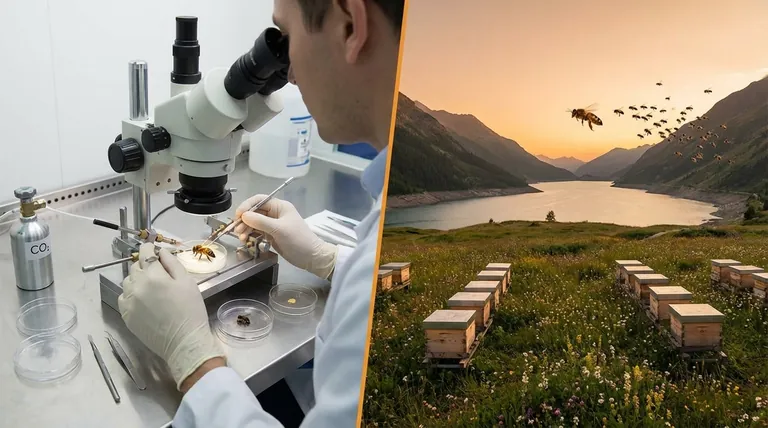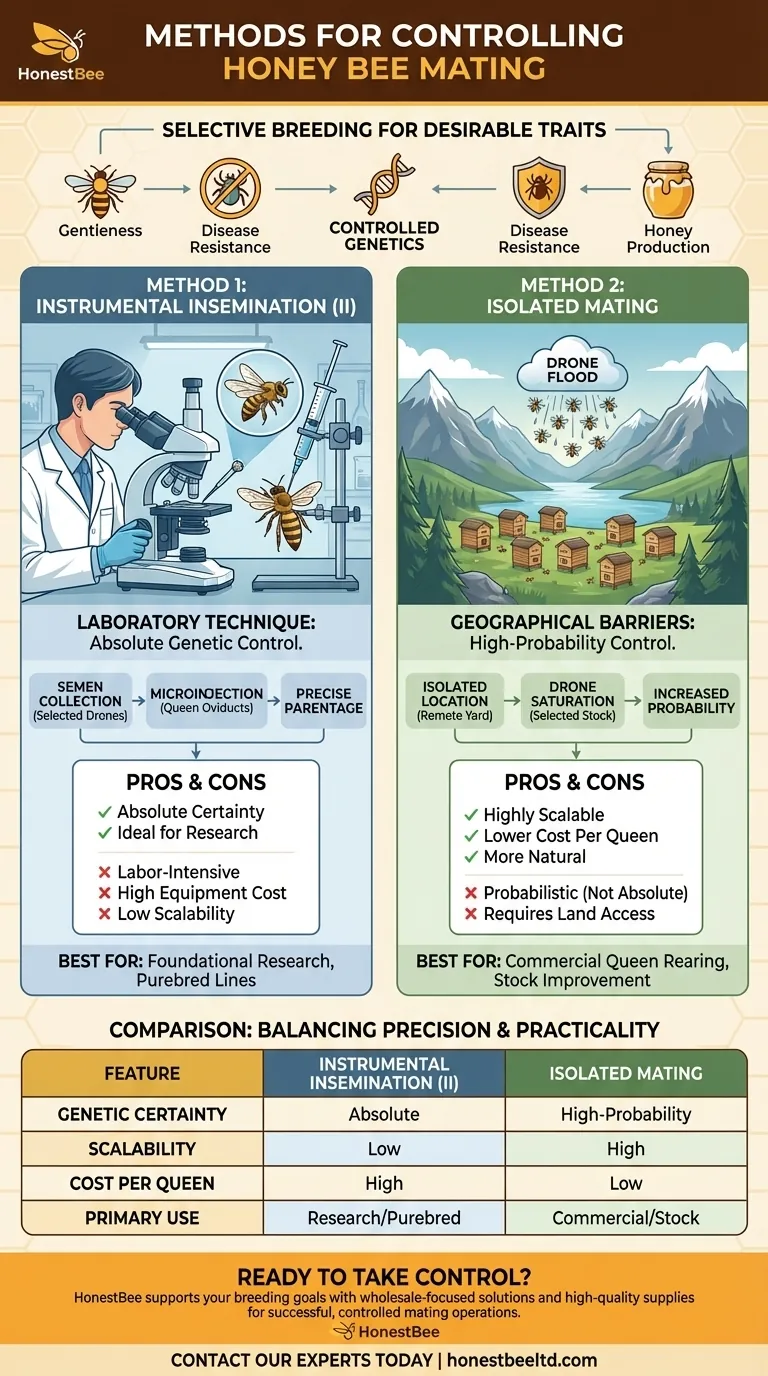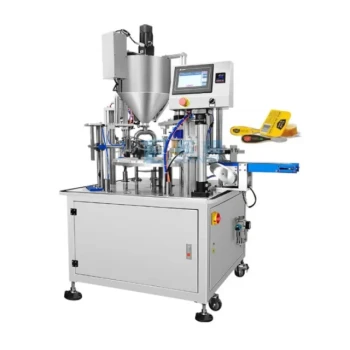Controlled honey bee mating is achieved primarily through two distinct approaches. These methods are Instrumental Insemination (II), a laboratory technique offering absolute genetic control, and Isolated Mating, which uses geographical barriers to ensure a queen mates only with drones from selected colonies. Each method serves different purposes, from foundational genetic research to large-scale queen rearing.
The core decision in controlling honey bee genetics is not about which method is superior, but about balancing the need for absolute certainty against the demands of cost, scale, and technical skill.

The Purpose of Controlling Mating
To appreciate the methods, it's crucial to understand why a beekeeper would interfere with the natural process. The goal is always selective breeding for desirable traits.
The Challenge of Natural Mating
In a natural mating flight, a virgin queen flies to a Drone Congregation Area (DCA), a specific location where drones from miles around gather.
She will mate with 10-20 different drones from many different colonies. This genetic diversity is excellent for the colony's vigor but makes it impossible to select for specific traits with any certainty.
The Goal of Genetic Selection
Controlled mating allows breeders to select for specific, heritable traits. These include gentleness, resistance to diseases and pests (like Varroa mites), honey production, and overwintering ability.
Method 1: Instrumental Insemination (II)
Instrumental Insemination is a highly technical, precise laboratory procedure that gives the breeder complete control over a queen's parentage.
The Process
Using a specialized microscope and micromanipulators, a trained technician collects semen from specific, pre-selected drones.
The virgin queen is briefly anesthetized with carbon dioxide, and the collected semen is injected directly into her oviducts, perfectly mimicking the outcome of natural mating.
The Primary Advantage: Absolute Certainty
With II, you know the exact paternal lineage of the queen's offspring. This is the only way to guarantee a specific genetic cross, which is essential for breeding programs and scientific research.
Method 2: Isolated Mating
Isolated mating is a more natural, scalable approach that relies on geography to limit a queen's mating options. It provides a high degree of control, but not absolute certainty.
The Principle of Isolation
A mating yard, containing small hives (mating nucs) with virgin queens, is established in a location far from any other honey bee colonies.
This isolation can be provided by mountains, large bodies of water, or simply vast agricultural areas with no other apiaries for several miles. The effective isolation distance must be greater than the flight range of drones.
Creating a "Drone Flood"
To ensure the virgin queens mate with the desired stock, the isolated yard is saturated with colonies that produce a high number of drones from the preferred genetic lines.
This "drone flood" drastically increases the probability that the queens will only encounter and mate with drones carrying the desired traits.
Understanding the Trade-offs
The choice between these two methods is a classic case of balancing precision against practicality. Neither is inherently better; they simply serve different objectives.
Control vs. Scalability
Instrumental Insemination offers perfect, predictable control. However, it is labor-intensive, requires expensive equipment and training, and can only be performed one queen at a time.
Isolated Mating is far more scalable. A single isolated yard can produce hundreds or thousands of well-mated queens in a season. The trade-off is that it offers probabilistic, not absolute, control, as a stray drone from outside the area could potentially mate with a queen.
Cost and Accessibility
II is expensive on a per-queen basis and requires significant upfront investment in equipment and training. This makes it inaccessible to most beekeepers.
Isolated mating requires access to suitable land and the resources to maintain a large number of drone-producing colonies, but the cost per queen is dramatically lower once established.
Making the Right Choice for Your Goal
Your breeding objectives will determine the most appropriate strategy for controlling your honey bee genetics.
- If your primary focus is foundational genetic research or creating a new purebred line: Instrumental Insemination is the only method that provides the absolute certainty required for this work.
- If your primary focus is improving stock for a commercial or sideline apiary: Isolated mating is the most practical and cost-effective approach for producing a large number of quality queens with desired traits.
- If your primary focus is simply raising local queens without a specific breeding program: Standard open mating is the default, relying on the natural genetic diversity of the bees in your area.
Understanding these methods empowers you to make intentional decisions that shape the future health and productivity of your colonies.
Summary Table:
| Method | Key Feature | Best For |
|---|---|---|
| Instrumental Insemination (II) | Absolute genetic certainty | Foundational research, creating purebred lines |
| Isolated Mating | High-probability control via geography | Commercial queen rearing, improving stock |
Ready to take control of your apiary's genetics?
Whether you're a commercial beekeeper aiming to scale up queen production with isolated mating nucs or a distributor seeking reliable equipment for advanced breeding programs, HONESTBEE is your partner. We supply the durable, high-quality beekeeping supplies and equipment that commercial apiaries and distributors trust for successful, controlled mating operations.
Contact our expert team today to discuss how our wholesale-focused solutions can support your specific breeding goals and enhance your operation's productivity.
Visual Guide

Related Products
- Queen Bee Artificial Insemination Instrument Equipment for Instrumental Insemination
- Plastic Chinese Queen Grafting Tool for Bee Queen Rearing
- HONESTBEE Advanced Ergonomic Stainless Steel Hive Tool for Beekeeping
- Professional Dual-End Stainless Steel Hive Tool for Beekeeping
- Professional 3-Bar Frame Grip with Integrated Hive Tool
People Also Ask
- How is success of honey bee artificial insemination evaluated? From Oviposition to Long-Term Queen Quality
- How long does it take to master instrumental insemination? A 2-Year Journey to Queen Rearing Proficiency
- What is the typical semen yield from a single honey bee drone? A Key Metric for Successful Queen Insemination
- What is the basic process of artificial insemination in honey bees? A Guide to Controlled Breeding for Superior Genetics
- What is the standard semen dose for AI of a honey bee queen? Master the 8-10 µl Precision for Longevity



















